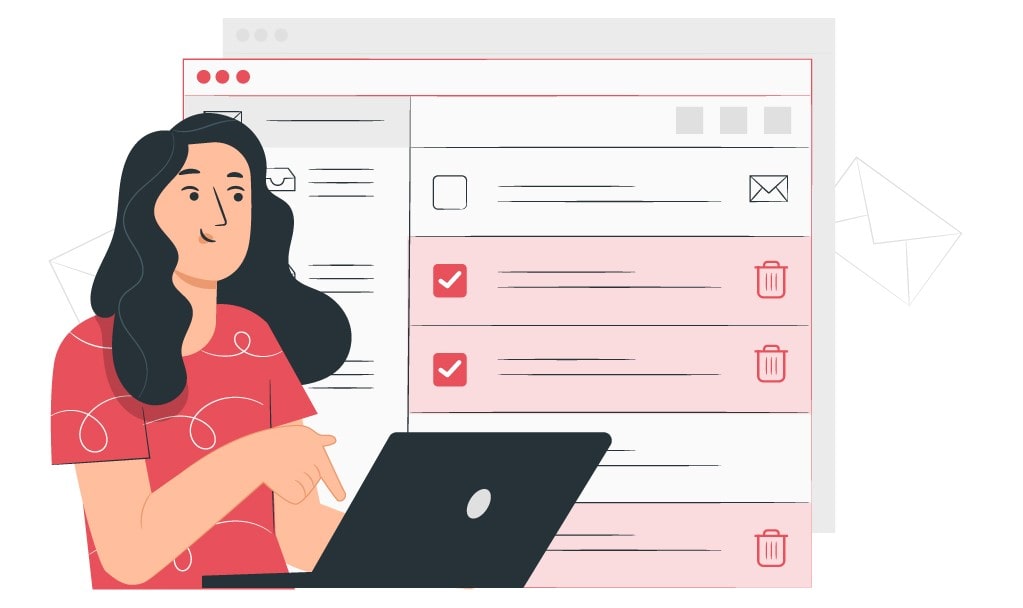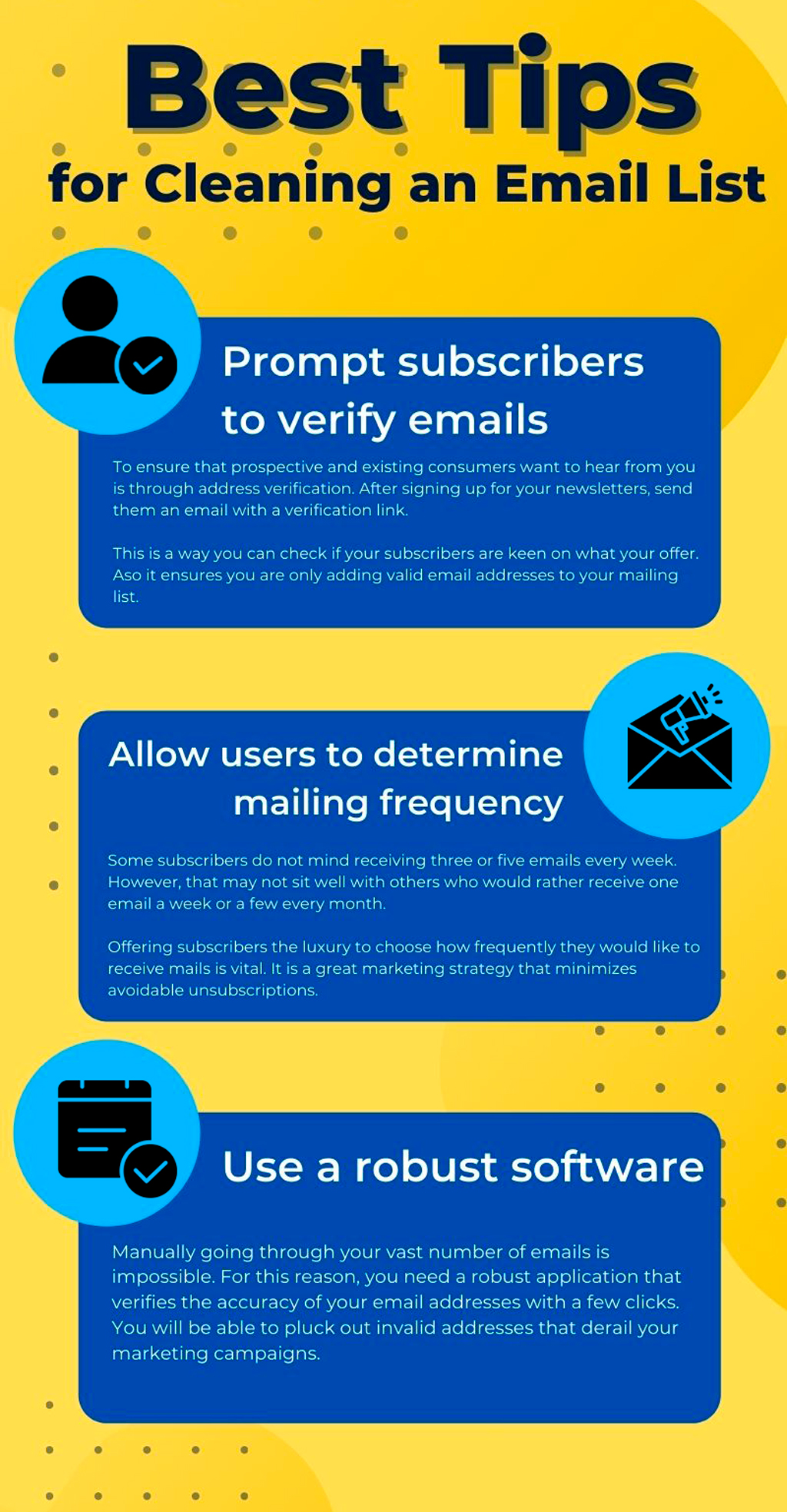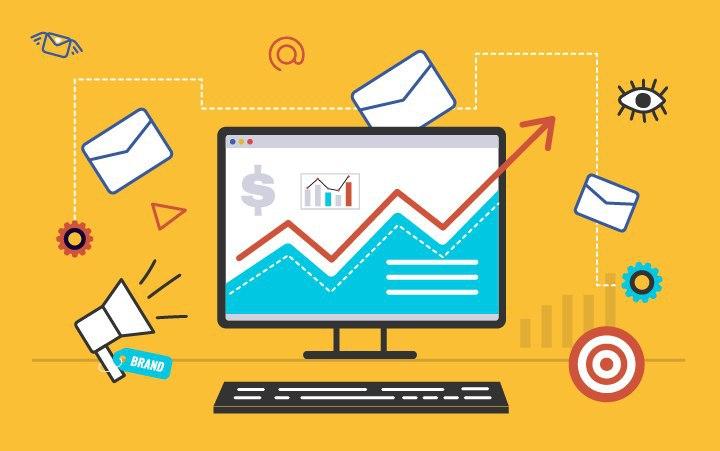Declining subscriber engagement is a common stumbling block in advertising. The level of enthusiasm a prospect shows when they first subscribe significantly goes down, which explains why open rates decrease from 50% to 29.55% over time.
As a marketer, unfruitful campaigns are things you want to avoid.
Also, considering that Litmus reported companies cut their email marketing budgets since the pandemic, the importance of only mailing people interested in what you offer cannot be over-emphasized.
And here’s where cleaning email lists saves the day!
What is email list cleaning
An email list clean up is the process of deleting unresponsive recipients to ensure you are only sending out emails to prospects who are particularly curious about your offerings.
By the way, for convenient management of letters use email studio. We also have convenient mail list software for managing email lists. Using the mass email extractor, you can collect email addresses for sending letters.
Benefits of email cleaning
Cleaning an email list has tremendous perks. They include:
- Better engagement rates
Forging better customer relationships is a strategy that ensures business longevity. Doing away with invalid addresses is vital as it narrows down your target audience, allowing you to focus on the select few that are keen on your products and services. That way, you can engage more and establish better connections with prospects, which is an excellent way to build brand loyalty.
- Improved ROI
If you are a company with a long mailing list, practicing email list hygiene is one of the surefire ways to stop paying extra bucks for email services and increase your overall bottom line.
Email service providers expect you to pay for all emails sent out, irrespective of whether it was delivered or not. Considering the marketing costs can escalate fast, sending emails to active users only is of paramount importance. It ensures that every dollar marketers use on advertising campaigns is worth it, allowing the company to reap from their marketing investment.
- Reduced spam complaints
Email users often flag unfamiliar messages as spam, even when it skips their minds that they subscribed a while ago. Unfortunately, Gmail and other similar service providers will keep a record of this.
In the event that they receive a couple of spam complaints, they may start sending your emails directly to spam. These are not only for those who flag your messages but also for other recipients.
By cleansing your list, you get rid of recipients who are likely to label your messages as spam. Thus, you can send out emails that are well-received.
- Fewer bounced emails
Bounced emails often occur due to void addresses and packed inboxes. Similar to spammed emails, those that bounce affect deliverability. When you clean up mailing list, you minimize bounce rates, which improves your reputation as a sender. That said, learning how to manage an email list cannot be overemphasized.
What to do before you scrub your email list
So, what steps should you take when conducting an email database cleaning?
- Categorize recipients
You need to create a table of contents and sort out your active and inactive (cold) recipients. Unlike their active counterparts, cold subscribers are those whose emails bounce and those that have not opened your emails for at least three months.
Before scrubbing, have these two groups in separate lists. Doing so allows you to take a customized approach, implementing different filtering parameters to improve the health of your list.
- Run them through a list cleaning service
Running inactive emails through list cleaning services will help you identify duplicate accounts, getting rid of them immediately. It will also figure out inactive subscribers that can be re-engaged.
- Re-engagement
Before doing away with the unresponsive recipients, try reconnecting with them.
Send them a re-engagement email with a well thought out subject line. ‘Before I go’ and ‘it’s goodbye from us’ are excellent subject lines that might prompt them to read your emails. Asking them to re-subscribe is a perfect strategy that will truly help you filter out uninterested parties.
- Re-organize
Once you send out the re-engagement email, note the people who respond. Then, move them to the active subscriber list and delete the rest.
To make your work on email campaigns even more convenient, we have developed software to extract emails from word on your computer. There is similar software for email hunting on websites. Then, using bulk mail sending software, you can make mass mailings. When all emails are sent, track them conveniently with the email tracking system.
What kind of emails you should remove
Now that you know how to clean an email list, you may wonder about the kinds of mail you need to eliminate.
They include:
- Duplicate emails
Sometimes, a reader might subscribe to your newsletters via two email addresses. In such a scenario, you can either delete the redundant email or merge them.
- Emails with spam filters
Spam filters are great as they kick unwanted emails to the curb. However, if these applications identify your emails as spam, they hurt your reputation and mailing services are likely to filter out even those you send to engaged readers. As such, deleting them is imperative.
- Emails that bounce
In this case, you must identify whether it is a hard or soft bounce.
Hard bounces are a deliverability issue that results from invalid email addresses. For example, the addresses could be fake or have typos. Since this is a permanent issue, such emails should be eliminated with immediate effect – unless, of course, it’s a typo such as ‘gmiil.com’, which you can correct and see whether it resolves the issue.
On the other hand, soft bounces result from temporary delivery problems that can be sorted out, such as a full inbox and an offline email server. For this type of deliverability issue, you need not delete the addresses. Instead, a great solution will be saving these contacts in a different list and seeing if they are viable later.
Tips for cleaning an email list
Some of the tips for cleaning large email lists include:
- Prompt subscribers to verify emails
One way to ensure that prospective and existing consumers want to hear from you is through address verification. After signing up for your newsletters, send them an email with a verification link.
This is a tactic that confirms your subscribers are keen on what your offer. Additionally, it ensures you are only adding valid email addresses to your mailing list.
- Allow users to determine mailing frequency
Some subscribers do not mind receiving three or five emails every week. However, that may not sit well with others who would rather receive one email a week or a few every month.
To meet everyone’s expectations, offering subscribers the luxury to choose how frequently they would like to receive mails is vital. It is a great marketing strategy that minimizes avoidable unsubscriptions while keeping everyone on your mail list content.
- Use a robust software
Manually going through your vast number of emails is impossible. For this reason, you need a robust application that verifies the accuracy of your email addresses with a few clicks. You will be able to pluck out invalid addresses that derail your marketing campaigns.
If you wonder how to scrub an email list, look no further than Atompark mail verifier. The application conducts a syntax and domain check that identifies typos and verifies the domain’s existence, respectively. Additionally, it confirms the viability of addresses, allowing you to get rid of inactive ones as needed.
Best practices for managing your cleaned list with Atompark List Manager
Atompark email list manager is an excellent application to help spruce up your mailing list. It automates the cleanup process, allowing you to do away with invalid addresses that increase your bounce rate and affect your overall deliverability score.
Additionally, the application allows you to specify filtering parameters, making the re-organization process more seamless. Meaning, that you can filter addresses that have, for instance, bounced twice or emails that have not been opened for a couple of months.
Once you clear email list, appropriately managing them is vital. Some of the best practices that should remain top of mind include:
- Practicing mail segmentation
If you don’t form a habit of feeding subscribers with information that appeals to them, sooner or later, you will be stuck in a rut.
To avoid this, practicing mail segmentation is recommended.
Group your subscribers according to their preferences. If you offer a variety of products and services, you can prepare personalized content and send it to its rightful audience. Otherwise, sharing information not in line with your subscribers’ needs will only get your mail lying in the inbox section unopened.
- Allowing them to unsubscribe
Sometimes, a recipient might no longer be enthusiastic about what your business offers. At that point, they should be able to easily opt-out.
If subscribers experience difficulties unsubscribing, they are likely to mark them as spam. Unfortunately, this portrays you as an untrustworthy source and harms your credibility with email service providers.
- Conduct a clean up regularly
Getting rid of unengaged subscribers is a continuous process. It is a crucial process that ensures your mailing list is of value. Generally, cleanups are done at least once or twice every year. However, your desired frequency highly depends on your number of recipients as well as your open and bounce rates.
Conclusion
Email list cleaning is a practice that aids in sending emails to prospective and existing customers keen on your offerings. It presents a surefire way to optimize your email marketing strategies.
As such, its importance cannot be over-emphasized.
The key is to prioritize the impact of each message rather than the number you send out. In addition, stay vigilant on subscriber behavior. What content piques their interest and has higher engagement? Which emails have the lowest open rates?
For the latter, you can personalize re-engagement emails, and then watch to see their response. Doing so will help you identify recipients that do not receive or open your emails and weed them out.
Streamline your cleanup process using the Atomic email verifier software. Get your 7-day trial here.
In our list of software there are also mobile extractor collecting phone numbers, whois for email addresses in order to find information about the owner of the email and a bulk email checker for checking the email address.









